By Jeffrey A. Rendall, Photos By Jeff Janas
QUEENSTOWN, MD -- It was the best of times, it was the worst of times. No, we're not stealing a line from Charles Dickens' 'A Tale of Two Cities' -- we're merely borrowing the phrase to make a comparison. While Dickens' 'tale' is a contrast between 18th century English and French societies, our golf 'tale' is about the two distinctly different nine hole playing stretches found at Atlantic Golf at Queenstown Harbor's Lakes Course.
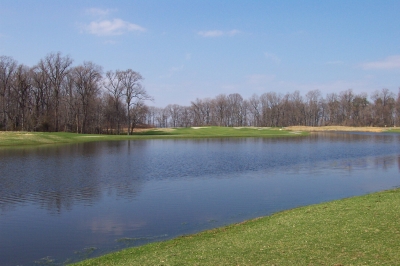 |
| Looking across at the 14th hole from the 15th fairway -- you'll feel fortunate that you won't have to go over this lake, just around it. |
Scot Forbis, Queenstown Harbor's Head Golf Professional, supplied the literary allusion: "The Lakes Course is really 'a tale of two nines.' You've got the front nine that's very player friendly -- it gets you pumped up a little bit, and you can hit some good shots and score well. Then, when you make the turn to the back nine, the difficulty increases dramatically, and really makes you buckle down."
Forbis continues, "I like the fact that the front nine allows you a little latitude right from the beginning. When we all start out playing, and maybe haven't played in a while -- the front nine won't put the screws to you right away. We all hate making a high number on the first few holes. But then, when you make the turn to the back side, there's no more practice time involved. You've got to play some good golf to score well, and if you're not warmed up by then, there's no one else to blame but yourself. I think the back nine on the Lakes Course is probably the most difficult nine at our facility."
Perhaps it was meant that way, as the Lakes' back nine was the final set designed by golf architect Lindsay Ervin (Ervin designed all 36 holes at the facility). Queenstown Harbor opened in 1991 with its River Course, expanded to 27 holes a few years later, and the Lakes Course came into being in 1996, combining the third and fourth nines into one complete layout.
 |
| Click on the banner to book a tee time at Queenstown's Lakes Course. |
Forbis speculated that maybe Ervin was balancing the friendly front nine with a more challenging closing nine. Or perhaps Ervin thought the front was the 'best of times,' and the back should be the 'worst of times' in order to even things out. Okay, probably not.
Because though the back nine certainly plays more difficult, it's still very playable and enjoyable (hardly the 'worst of times'). The River Course gets most of the attention when people talk about Queenstown Harbor, but the Lakes Course is every bit as aesthetically pleasing and challenging as its older sibling -- the difference being there's only a fleeting glimpse of the Chester River (which feeds into the Chesapeake), whereas several holes on the River Course play alongside the great body of water.
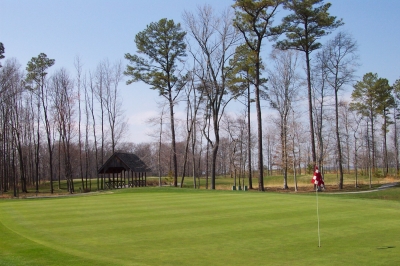 |
| From the 11th green, you can glance across at the covered bridge near the 17th tee. Peaceful, tranquil scenes, often repeated. |
Besides the terrific golf on the two golf courses, there's also the incredibly interesting 'tale' behind the property itself. Charlie Birney, co-owner of Atlantic Golf, tells the story: "Legend has it that way back in Colonial times, Cecil Calvert, the second Lord of Baltimore, wanted to reward Henry deCoursey, his Secretary of State, for deCoursey's excellent treaty negotiating services. So he called him into his office. And as was customary at that time, Calvert offered deCoursey as much land as he could cover on a map with his thumb print -- in return for deCoursey's excellent work."
"I'm not exactly sure what the scale of the map was, or the size of deCoursey's thumb, but the thumbprint covered portion turned out to be about 1500 acres. Hence, it was called a 'thumb grant.' deCoursey then took the land and turned it into a farm, calling it 'My Lord's Gift Farm' thereafter," Birney adds.
Today, it looks a bit different, we'd speculate, but there are still some 'farm' elements on property, such as a barn and outbuildings that remain in use (for the golf facility), as well as an abundance of furry and feathered creatures all around -- but no cows and chickens (at least that we could see).
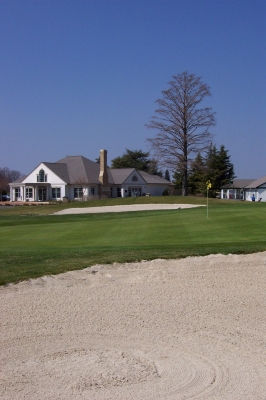 |
| The Lakes' 9th green is within view of the clubhouse and starter's hut. Pressure putting defined. |
The Lakes Course is hardly pastoral, though. As the name would suggest, there's quite a bit of H2O on the layout, as well as a few tight tree-lined holes and environmental areas you'd find on any modern layout. The course 'only' plays to 6569 yards from the back tees, but that doesn't mean the short-hitting high handicapper should hitch up his belt, draw the cover off his driver and casually saunter to the deep set.
Forbis explains: "The 'short' yardage figure on the Lakes Course can be a bit deceptive. Though I'd say there really aren't any super-difficult forced carries, there are a few tee shots out there where you'll need to get some air under the ball to avoid trouble."
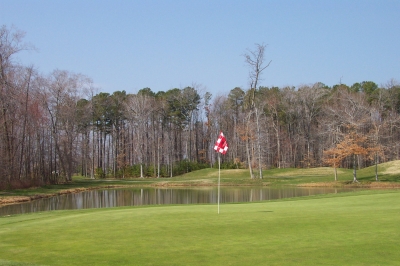 |
| The 6th green is protected by water on both sides. One of many holes where water figures prominently on the Lakes Course. |
"And of course we have our tee suggestion system whereby we recommend tees based on how long you fly the ball. Still, some people just seem to look at scorecard yardage and base their decisions on the numbers. I'll hear guys talking about what tees to play, and they'll say 'Oh gosh, it's only 6500 yards or whatever, let's play from the back.' I'll tell 'em, "Guys, you don't know. When you make the turn to the back side and you're on some of those holes, it's a long golf course." A lot of the shortness in the course is on a few of the 'easy' par fours, like one and nine," Forbis added.
Scorecards rarely reveal the true depth of the challenge, and that's very true on the Lakes Course. Take the thirteenth hole for example. It's 450 yards (par four) from the back tees, and if the wind's in your face (according to Forbis, it often is), it's a three shot hole for most of us.
Forbis says the 'distance myth' leads to a lot of normally 'white tee' players moving all the way back, and suffering the consequences.
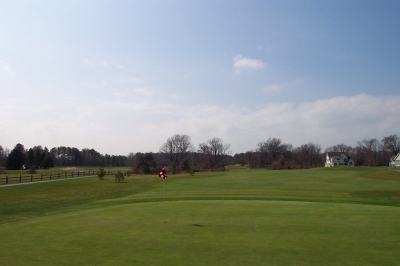 |
| On the 2nd hole, it's easy to see how the land was once a farm -- and the beauty helps you understand why it was called 'My Lord's Gift Farm.' |
And even if you've got the length to tame the beast, the sheer number of water hazards on the Lakes Course demands effective course management. Forbis describes it: "You can get away, quite easily, without playing driver on some of the holes. But if you hit the tee shot off-line, or if you put yourself in the big, high love grass or in the bunkers, you're pretty much cooked at that point. Take advantage of the course's shorter holes to put it in the fairway, and you can definitely negotiate the rest of the golf course. The critical part is the tee shot on the Lakes Course."
Again, Forbis is right on (as he should be). Once you've safely reached the landing areas, the shots into the greens aren't overly difficult. Nearly all the holes allow for a short approach that won't find trouble. And the greens are big enough to receive shots and hold them -- with only moderate bunkering.
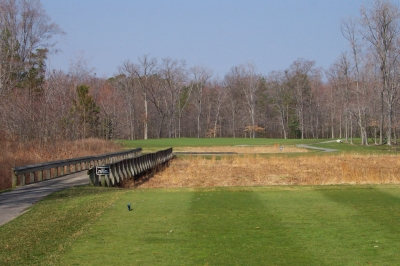 |
| There's a mild forced carry on the 6th tee -- but from the back tees, you'll still need to fly it about 200 yards to clear it. |
A final note before describing a few of the highlight holes, is conditioning. Having played the full compliment of Atlantic Golf's courses, you'll find better than average conditions on all of them -- and when you factor in the reasonable pricing at the Lakes Course, you're especially impressed. Forbis says you'll pay a lower fee to play the Lakes, but there's the same level of conditioning for both courses.
As amply introduced above, the front nine starts off rather tame, with a 362 yard par four the doglegs slightly right. Not only is the hole pretty short, there's tremendous 'miss room' on either side of the fairways, too.
Skipping to four, you'll find yet another hint at the 'best of times' vs. 'the worst of times' theme. 504 yards from the tips (par five), this dogleg right par five is dictated by the wind, a lake that runs the entire length of the hole on the right side, and according to Forbis, your nerves. "It's a simple par five, at least in distance. If you pick the right spot off the tee, you can cut a lot off the corner. I've hit 9-iron into that green on my second shot. But if you misjudge the distance on the tee, you're in the lake. Or, if you're afraid of the corner and pull it -- that brings the tree-line (on the left side) into play. I haven't made better than double bogey on that hole in two years -- and people look at me like I'm crazy."
 |
| Click on the banner to book a tee time at Queenstown's Lakes Course. |
Five is probably the toughest hole on the front side, 420 yards in length and a dogleg left that isn't apparent from the tee. First-timers beware, because if you leak your tee ball too far to the right off the tee, it's a fairway wood and then some to a green protected by water on the right.
Turning to the back, the par four 13th is a tremendously challenging hole. There's a pond and wetlands to the extreme right off the tee, and a bunker on that side suggests where you should be playing. Take a long-iron or fairway wood to the green, but don't go right -- because there's more water waiting.
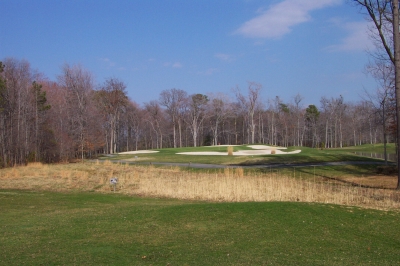 |
| Taking a look at the 17th hole, it's easy to see why the 210 yard par three is Scot Forbis' favorite. |
Fifteen is a nice par five. Again, not overly long at 525 yards, but winding right around a lake (Slicers beware on the back nine, as water hugs the right sides of 12, 13, 14, 15 and 17). A series of bunkers guards the left side of the hole, and large bunkers protect both sides of the green.
Forbis says seventeen is his favorite hole: "It's a long par three from the back tee (210 yards), and the green is pretty large -- it's a three club green, easy. So you've got to pay attention to the pin position for club selection, or potentially leave a sizeable putt. Once on the green, there's enough slope where you'll have to whack it going up, or be careful going down. It's a well thought out hole."
What else would you expect from this pleasant golf course in a beautiful setting? Lots of thinking went into the entire Queenstown Harbor facility -- that much is obvious. Come on out if you're in the mood for the 'best of times' -- and leave the 'worst of times' behind you.
Details:
Atlantic Golf at Queenstown Harbor (Lakes Course)
310 Links Lane
Queenstown, MD 21658
Phone: (410) 827-6611; Toll Free: (800) 827-5257
FAX: (410) 827-5258
Website: www.mdgolf.com
Course Architect: Lindsay Ervin
Head Golf Professional: Scot Forbis
Co-owner: Charlie Birney
| Tees | Yardage/Slope | Rating |
| Green | 6569/124 | 71.0 |
| Blue | 6058/118 | 68.4 |
| Gold | 5246/105 | 65.0 |
| White | 4606/111 | 66.6 |
Rates: (In Season)
The River is $76 M-Th. $99 F-Sun. Twilight: After 3, $56 M-Th, $65 Fri-Sun. Pre-Twilight rates also available. Junior and replay rates also available.
The Lakes is $60 M-Th. $79 F-Sun. Twilight: After 3, $46 M-Th, $55 Fri-Sun. Pre-Twilight rates also available. Junior and replay rates also available.
Rates include cart. Unrestricted walking policy.
| Related Links | Comments on this article? | |
|
Maryland National Golf Club Hollow Creek Golf Club Rocky Gap Resort PB Dye Golf Club in Ijamsville Whiskey Creek Golf Club |
E-mail Jeff Rendall, Editor: jrendall@golftheunitedstates.com |












